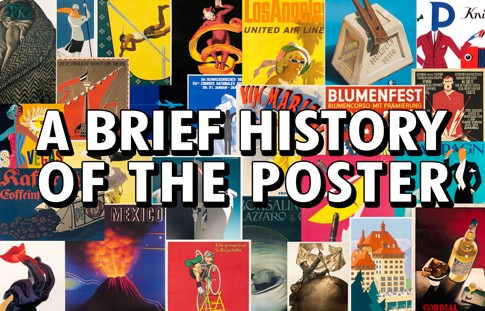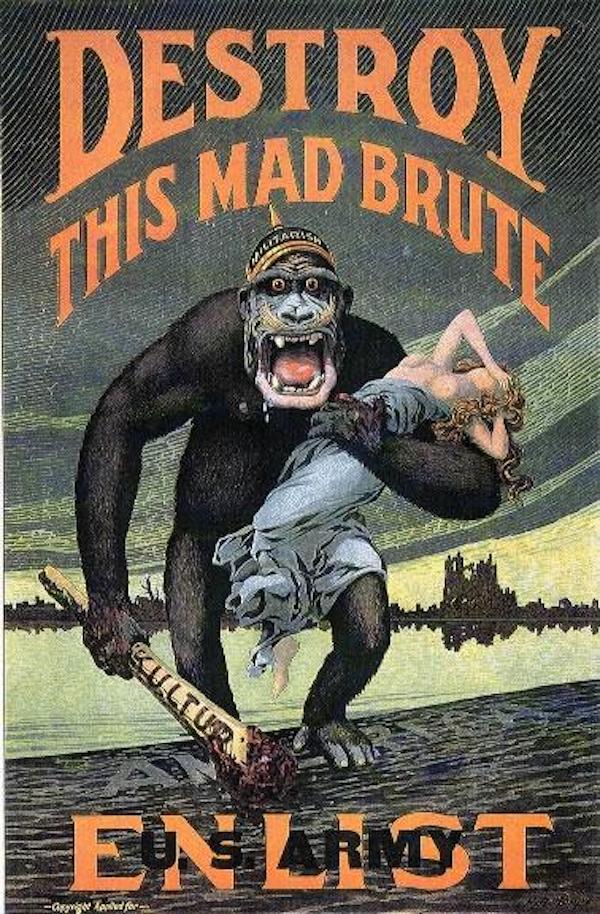A Brief History of the Poster
- 3 Jan 2023

A Brief History of the Poster
Posters have been used as a form of advertising for over a century. From the early days of hand-drawn posters to the digital age of poster printing, the use of posters as a medium for promoting products, services, and events has evolved significantly. This blog post explores the history of posters, from their early origins to the present day, highlighting the key developments and innovations that have shaped the poster as we know it today.
We often take posters for granted. After all, they’re such a valuable tool for communication that it can seem like they’ve been around forever. But did you know that posters as we know them only date back to the 1880s? Modern posters originate in the late 19th century and have since gone on to change the advertising game around the globe
Posters are a brilliant and impactful way to communicate all kinds of messages. They are informative, affordable, and pack a huge visual punch – people just can’t help but pay attention!

Here is a brief timeline of the history of posters:
- Early origins of posters as hand-drawn advertisements
- Development of lithography and the use of photography
- Shift to digital printing and advancements in technology
- Evolution of poster design and use over time
- Use of posters to promote products, services, and events
- Adaptation of poster use to changing technology and audience preferences
- Comparison of poster advertising with other forms of advertising
- Impact of digital media on poster advertising
- Future of poster advertising and potential innovations.
The invention and refinement of lithographic posters
Lithography dates all the way back to 1798, but it was a costly system for decades. However, in the 1880s, Cheret’s “3 stone lithographic process,” changed the game. It allows poster artists to include a vast array of colours on their posters with just three printing ‘stones’ – red, blue, and yellow.
Despite the simple method, Cheret’s method produced bold and vibrant colours and textures. For the first time, posters really stood out on the landscape, and advertisers ate them up.

Belle Epoque and Art Nouveau posters 1890 – 1910
Toulouse-Lautrec unveiled his iconic Moulin Rouge poster in 1891, and a new era was born. The Belle Epoque saw thousands of stunning and unique posters displayed across France and beyond – Parisian ad dealer Sagot had more than 2200 different signs on offer in his mid 1890s catalogue! Czech artist Alphonse Mucha, influenced by Byzantine art, the Pre-Raphaelites, and the Arts and Crafts Movement, soon developed a signature style that is still emulated today. His flowery, ornate posters would come to define the Art Nouveau movement. Art Nouveau became the most popular art and design movement in the 1910s and ’20s, along with Futurism, Cubism, Expressionism, and Dadaism.

Propaganda Posters during the Bolshevik Revolution and World War I
Some of the most pivotal events of the early twentieth century would be defined by poster art. During the chaos of WWI, posters were employed to recruit soldiers, sell bonds, and stoke outrage at enemy transgressions. In the USA alone, more than 2,500 poster designs and 20 million posters were produced in just two years!
When it comes to posters, the Bolsheviks in Russia were no slouches themselves! Lenin and the gang designed hundreds of posters to promote their cause. Posters would go on to become an important weapon in World War II and the Cold War.

Modernism and Art Deco between the Wars 1919 -1938
Between the Wars, the Soviet Union began pumping out Constructivist art that intended to agitate the public and force support for social change. Rodchenko, Klutsis, El Lissitsky, and the Stenberg Brothers became revolutionary poster inspiration, even in the West.
By the mid-’20s, the bold colours and diagonal lines inspired the Bauhaus and de Stijl, leading to the decorative movement known as Art Deco. Drawing from Egyptian and Middle Eastern designs, the streamlined text and sleek angles would appear on posters across the globe. Airbrushing, still in its infancy, became an important technique. You can see the admiration for the Industrial Age in A.M. Cassandre’s posters for massive ocean liners, including the Normandie, Statendam, and Atlantique.


World War II propaganda, and an end to stone lithography
During World War II, posters once again played a key role in boosting morale through propaganda. The photo offset technique was commonly used, leading to the signature ‘dot’ appearance so characteristic of comic strips and newspapers. Alongside illustration, photography became more commonplace, and the Swiss Sachplakat, or Object Poster Style, reigned supreme.

Mid-century modernism in the 1950s and early ’60s
The ‘baby boom’ of the 1950s and early ’60s spelt out a whole new era of consumerism and advertising. Travel, television, and convenience foods all leaned heavily on poster art, ushering in a new era of mid-century design. Bright colours, streamlined text, and aspirational copy all embody the posters of this era. No artists exemplify this more than Paul Rand and Dan Reisinger – think Mad Men!

Psychedelia and Rebellion the late ’60s and ’70s
While the rigid design elements of the ’50s and ’60s suited the straightlaced times, the wild hippie rebellion of the late ’60s and ’70s necessitated wilder designs. Pop Art, Surrealism, and Psychedelic design took over the global design ethos. Psychedelia, which borrows heavily from the organic shapes of Art Nouveau, defines the era, particularly in album and concert posters.

Post Modernism in the 1970s and ’80s
The late ’70s and the ’80s saw yet another shift in design, to more geometric designs, simple text, and bold shapes. Bright, primary colours were in fashion, as were asymmetrical shapes and pop-art inspired branding messages. This style is having quite the resurgence – think of the graphics used in Stranger Things and the film Drive.


The tech revolution of the 1990s and ’00s
Through the late ’90s and first decade of the 2000s, the world was experiencing a shift towards the advanced tech and the wonders of the ‘brand new’ internet. Posters of the ’90s feature a lot of digital imagery – think the Matrix or Hackers.

Conclusion:
In conclusion, posters have come a long way from their early origins as hand-drawn advertisements. The development of lithography, the use of photography, and the shift to digital printing have all played a significant role in shaping the poster as we know it today. Posters have been used throughout history to promote products, services, and events, and their use has adapted to changing technology and audience preferences. While the advent of digital media has had an impact on poster advertising, it remains a relevant and effective form of advertising. The future of poster advertising holds potential for further innovation, and it will be interesting to see how it continues to evolve.
Now that we are entering a whole new decade, what trends have you seen in posters and advertising? No matter the trend of design, posters always look their best when they’re framed in high-quality poster frames. Poster frames prevent them from getting tatty and ragged, as well as stop vandals and thieves from ruining your expensive printing expenditures.
Do you use posters in your business? If so, the best way to display them is in high-quality poster frames. Choose poster frames that suit your design and stand up to the elements. Not only do they protect and preserve your costly printing expenditures, snap poster frames add a neat and tidy border to your posters. So if you need some advice about which poster frames will suit your needs? Get in touch with the Red17 team, and our experts will answer all of your questions.
If you enjoyed this article, you may also like…
Poster Frames 101: Everything You Need to Know
Shop here:
